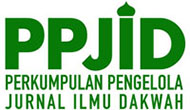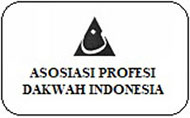Pemetaan untuk Strategi Dakwah di Kota Semarang Menggunakan Pendekatan Data Mining (Mapping for Da'wah Strategy in Semarang City Using Data Mining Approach)
Abstract
This paper aims to explore the potential of da'wah in the city of Semarang with a data mining approach. The data mining approach is carried out by implementing the fuzzy c-means (FCM) algorithm in order to obtain the optimum number of clusters in the potential clustering of da'wah in the city of Semarang. The data used in this study from the Ministry of Religion of the Republic of Indonesia and the Central Statistics Agency (BPS) of Semarang City. The results of the FCM analysis show that the optimum number of clusters is two clusters, where the sub-district in the second cluster is an area with a high potential for da'wah. This study provides information that in effective da'wah activities, certainty and clarity is needed regarding the targets of da'wah through mapping of da'wah in the form of clustering potential da'wah. This can be a consideration of dakwah strategies for the successful implementation of da'wah studies so that an increase in the target behavior of da'wah can be achieved. The application of FCM to get the optimum cluster of potential da'wah in order to produce da'wah mapping is novelty in the field of Islamic studies, especially the science of da'wah.
Keywords
Full Text:
PDFReferences
Abdul Syukur, A., Putra, R. A., Saifullah, S., & Rolanda, D. M. (2020). Haji Oemar Said Tjokroaminoto: Biografi, Dakwah dan Kesejahteraan Sosial. Jurnal Dakwah Dan Komunikasi, 5(2), 177. https://doi.org/10.29240/jdk.v5i2.2154
Alguliyev, R. M., Aliguliyev, R. M., & Sukhostat, L. V. (2021). Parallel batch k-means for Big data clustering. Computers and Industrial Engineering, 152, 107023. https://doi.org/10.1016/j.cie.2020.107023
Amin, H. M., Pai, P., Tarbiyah, F., & Bone, I. (2020). DAKWAH KULTURAL MENURUT PERSPEKTIF PENDIDIKAN ISLAM. In Atta’dib Jurnal Pendidikan Agama Islam (Vol. 1, Issue 2). IAIN Bone. https://doi.org/10.30863/ATTA’DIB.V1I2.1023
Aminah, S., Ap, I., Zulkarnaim, N., & Kesehatan, A. (2019). Clustering Wilayah berdasarkan Data Kesehatan Lingkungan menggunakan Fuzzy C-Means. JCIS (Journal of Computer and Information System), 1(2), 12–22. https://doi.org/10.31605/jcis.v2i1
Asmuni, A. (2017). FILSAFAT DAN DAKWAH. In ORASI: Jurnal Dakwah dan Komunikasi (Vol. 8, Issue 1). https://doi.org/10.24235/ORASI.V8I1.2023
Dolok Lauro, M., & Erny Herwindiati, D. (2020). SISTEM PREDIKSI CUSTOMER LOYALTY DENGAN METODE RFM DAN FUZZY C-MEANS. In Computatio: Journal of Computer Science and Information Systems (Vol. 4, Issue 1). https://doi.org/10.24912/COMPUTATIO.V4I1.7099
Farooqui, J. (2014). The Sociological Approach to Islamic Da‘wa. Journal of Islam in Asia, 11(2).
Feri Musharyadi, M. K. (2017). TINGKAT PEMAHAMAN MAHASISWA TERHADAP NORMA NORMA AGAMA ISLAM MENGGUNAKAN ALGORITMA K-MEANS CLUSTERING. Menara Ilmu, 11(78). https://doi.org/10.33559/MI.V11I78.576
Galimberti, G., & Soffritti, G. (2020). A note on the consistency of the maximum likelihood estimator under multivariate linear cluster-weighted models. Statistics and Probability Letters, 157, 108630. https://doi.org/10.1016/j.spl.2019.108630
Gusman, A. P., & Kurniawan, H. (2018). FUZZY LOGIC DALAM MENGANALISA PENGARUH KONSEP HALAL TOURISM TERHADAP PERILAKU MASYARAKAT SUMATERA BARAT. Jurnal Matematika UNAND, 7(2), 235–242. https://doi.org/10.25077/JMU.7.2.235-242.2018
Hayati, U. (2017). NILAI-NILAI DAKWAH; AKTIVITAS IBADAH DAN PERILAKU SOSIAL. INJECT (Interdisciplinary Journal of Communication), 2(2), 175. https://doi.org/10.18326/inject.v2i2.175-192
Iaboni, D. S. M., Farrell, S. R., & Chauhan, B. C. (2020). Morphological multivariate cluster analysis of murine retinal ganglion cells selectively expressing yellow fluorescent protein. Experimental Eye Research, 196, 108044. https://doi.org/10.1016/j.exer.2020.108044
Iskandar, I., Mahmud, N., Syamsuddin, D., & Jasad, U. (2018). DAKWAH INKLUSIF DI KOTA PAREPARE. KOMUNIDA : MEDIA KOMUNIKASI DAN DAKWAH, 8(2), 168–182. http://almaiyyah.iainpare.ac.id/index.php/komunida/article/view/632
Khalili-Damghani, K., Abdi, F., & Abolmakarem, S. (2018). Hybrid soft computing approach based on clustering, rule mining, and decision tree analysis for customer segmentation problem: Real case of customer-centric industries. Applied Soft Computing Journal, 73, 816–828. https://doi.org/10.1016/j.asoc.2018.09.001
Khan, I., Luo, Z., Shaikh, A. K., & Hedjam, R. (2021). Ensemble clustering using extended fuzzy k-means for cancer data analysis. Expert Systems with Applications, 172, 114622. https://doi.org/10.1016/j.eswa.2021.114622
Kucherov, A., & Kurenkov, V. (2017). Use of Cluster Analysis for Development of Star Tracker Mass Statistical Model. 6th Russian-German Conference on Electric Propulsion and Their Application, 185, 227–230. https://doi.org/10.1016/j.proeng.2017.03.304
Kunis, S., & Nagel, D. (2020). On the smallest singular value of multivariate Vandermonde matrices with clustered nodes. Linear Algebra and Its Applications, 604, 1–20. https://doi.org/10.1016/j.laa.2020.06.003
Lurka, A. (2021). Spatio-temporal hierarchical cluster analysis of mining-induced seismicity in coal mines using Ward’s minimum variance method. Journal of Applied Geophysics, 184, 104249. https://doi.org/10.1016/j.jappgeo.2020.104249
Malik, R. A., Defit, S., & Yuhandri, Y. (2018). Comparison of K-Means Clustering Algorithm with Fuzzy C-Means In Measuring Satisfaction Level Of Television Da’wah Surau TV. Rabit : Jurnal Teknologi Dan Sistem Informasi Univrab, 3(1), 10–21. https://doi.org/10.36341/rabit.v3i1.387
Mandour, T. . (2010). Islam and Religious Freedom: Role of Interfaith Dialogue in Promoting Global Peace. Law Review ((BRIGHAM YOUNG UNIVERSITY), 888–889.
Medriosa, H. (2014). Metode Cluster Analysis. Jurnal Momentum, 16(2), 17–23.
Meuleman, J. (2011). Dakwah, competition for authority, and development. Bijdragen Tot de Taal-, Land- En Volkenkunde (BKI), 167(2/3), 236–269.
Muhyiddin, A. S. (2019). DAKWAH TRANSFORMATIF KIAI (Studi terhadap Gerakan Transformasi Sosial KH. Abdurrahman Wahid). Jurnal Ilmu Dakwah, 39(1), 1. https://doi.org/10.21580/jid.v39.1.3934
Novitasari, D. C. R., Faqih, A., Wahyudi, N., Ulinnuha, N., Ulya, Z., Mustofa, A., Fauzi, A., Asyhar, A. H., Kusaeri, Rolliawati, D., & Yusuf, A. (2021). Identify Education Quality Based on Islamic Senior High School Data in Kompetisi Sains Madrasah Using Fuzzy C-Means Clustering. Smart Innovation, Systems and Technologies, 182, 487–495. https://doi.org/10.1007/978-981-15-5224-3_49
Nurjanah, Farmadi, A., & Indriani, F. (2014). Implementasi Metode Fuzzy C-Means Pada Sistem Clustering Data Varietas Padi. Jurnal Ilmu Komputer, 01(01), 23–32.
Oreški, D., Konecki, M., & Milić, L. (2017). Estimating profile of successful IT student: Data mining approach. 2017 40th International Convention on Information and Communication Technology, Electronics and Microelectronics, MIPRO 2017 - Proceedings, 723–727. https://doi.org/10.23919/MIPRO.2017.7973517
Putra, D. T. K. R. I. (2018). FUZZY CLUSTERING MEANS (FCM) DALAM PENENTUAN LOKASI PENERTIBAN PENYAKIT MASYARAKAT PADA KEGIATAN PEMBINAAN SOSIAL SATPOL-PP WILAYAH SUMATRA-BARAT. PETIR, 10(1). https://doi.org/10.33322/petir.v10i1.33
Ramos, T. G., Machado, J. C. F., & Cordeiro, B. P. V. (2015). Primary education evaluation in Brazil using big data and cluster analysis. Procedia Computer Science, 55, 1031–1039. https://doi.org/10.1016/j.procs.2015.07.061
Rezi, M. (2020). Moderasi Islam Era Milenial (Ummatan Wasathan Dalam Moderasi Islam Karya Muchlis Hanafi). Istinarah: Riset Keagamaan, Sosial Dan Budaya, 2(2), 16–30. https://doi.org/10.31958/ISTINARAH.V2I2.2405
Roux, S., Buis, S., Lafolie, F., & Lamboni, M. (2021). Cluster-based GSA: Global sensitivity analysis of models with temporal or spatial outputs using clustering. Environmental Modelling and Software, 140, 105046. https://doi.org/10.1016/j.envsoft.2021.105046
Rustandi, R. (2020). Dakwah Komunitas di Pedesaan dalam Perspektif Psikologi Komunikasi. Irsyad : Jurnal Bimbingan, Penyuluhan, Konseling, Dan Psikoterapi Islam, 8(3), 305–326. https://doi.org/10.15575/irsyad.v8i3.2009
Saragih, M. Y. R. (2020). Dakwah Via Jurnalistik Radio. An Nadwah, 25(1), 64–74. https://doi.org/10.37064/AN-NADWAH.V25I1.7481
Suriati, Burhanuddin, & Nur, M. J. (2020). Da’wah in Form of Ukhuwah Islamiyah. 941–946. https://doi.org/10.2991/assehr.k.200529.198
Vialetto, G., & Noro, M. (2020). An innovative approach to design cogeneration systems based on big data analysis and use of clustering methods. Energy Conversion and Management, 214, 112901. https://doi.org/10.1016/j.enconman.2020.112901
Wahyudin, A. (2019). Peran Organisasi Nahdlatul Ulama’ dalam Menangkal Faham Radikalisme. Proceeding: Faqih Asy’ari Islamic Institute International Conference (FAI3C), 2, 88–103. http://proceeding.iaifa.ac.id/index.php/FAI3C/article/view/18
Yu, K., Liu, Z., Zhao, G., Li, J., Zeng, X., & Wang, Z. (2021). A novel protection method for a wind farm collector line based on FCM clustering analysis. International Journal of Electrical Power and Energy Systems, 129, 106863. https://doi.org/10.1016/j.ijepes.2021.106863
Yusuf, A. (2018). MODERASI ISLAM DALAM DIMENSI TRILOGI ISLAM (AKIDAH, SYARIAH, DAN TASAWUF). In Jurnal Al-Murabbi (Vol. 3, Issue 2). http://jurnal.yudharta.ac.id/v2/index.php/pai
Zhang, L., Wang, Y., & Wu, X. (2021). Cluster-based information fusion for probabilistic risk analysis in complex projects under uncertainty. Applied Soft Computing, 104, 107189. https://doi.org/10.1016/j.asoc.2021.107189
Zuhdi, M. H., Saleh, M., Abdullah, M. N., Mujib, L. S. Bin, & ... (2017). Peta Dakwah Majelis Ulama Indonesia Nusa Tenggara Barat. Majelis Ulama Indonesia (MUI) Provinsi NTB. http://repository.uinmataram.ac.id/id/eprint/50
DOI: http://dx.doi.org/10.24014/jdr.v32i1.12549
Refbacks
- There are currently no refbacks.

This work is licensed under a Creative Commons Attribution-ShareAlike 4.0 International License.
Editorial Office:
2nd Floor, Building of Faculty of Da'wah and Communication, Universitas Islam Negeri Sultan Syarif Kasim Riau. Jl. HR Soebrantas Km 15, Simpangbaru, Tampan, Pekanbaru
Email : jurnalrisalah@uin-suska.ac.id

This work is licensed under a Creative Commons Attribution-ShareAlike 4.0 International License.















